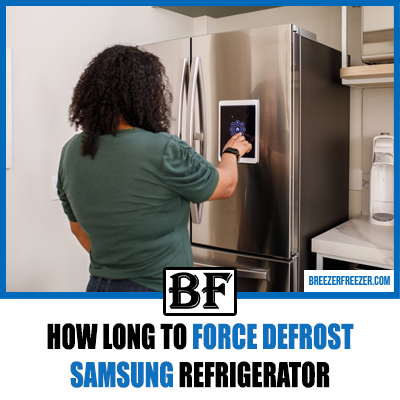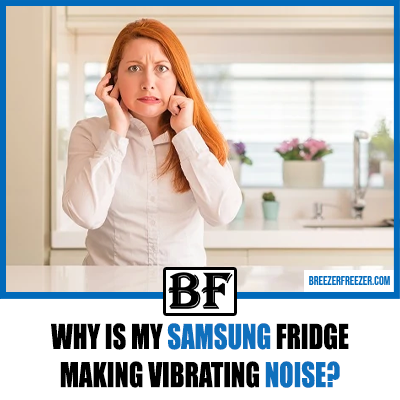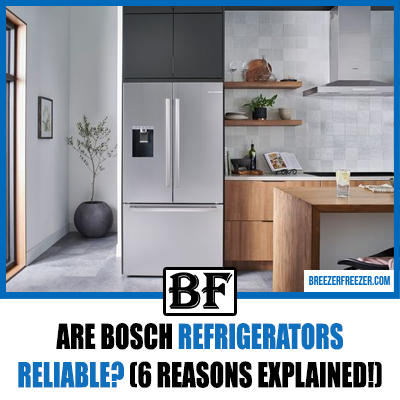Hisense Refrigerator Troubleshooting Guide (6 Issues Fixed!)
Hisense refrigerators have gained a reputation as highly improved and reliable appliances in the market. However, like any other refrigerator, they can encounter issues.

By performing basic Hisense refrigerator troubleshooting, you may be able to resolve some of these problems on your own.
Common problems that you can troubleshoot with Hisense refrigerators include issues with functionality, cooling, ice-making, freezing, and unresponsive buttons or display. Additionally, you can troubleshoot common error codes specific to Hisense refrigerators.
While certain problems may require the expertise of a professional, it is advisable to attempt troubleshooting before immediately contacting them. To assist you in this process, this troubleshooting guide will address the underlying causes of these six common refrigerator problems and provide applicable solutions.
By the end of this guide, you should have a better understanding of why your Hisense refrigerator is behaving a certain way and how to rectify the issue. Let’s begin troubleshooting!
Quick Troubleshooting Guide
| Problem | Likely Cause | Recommended Fix |
| Hisense Refrigerator Not Working | Power fault, defective door switch, thermostat, or compressor, or leaked refrigerant | Check the unit’s power supply, replace a defective door switch, thermostat, or compressor, and call a professional to fix a refrigerant leak, if present |
| Hisense Refrigerator Not Cold | Power fault, wrong control setting, Demo Mode, food overload, leaky door, clogged vents and coils, non-working compressor, or defective thermostat, evaporator fan, or condenser fan | Ensure the refrigerator has power, set the temperature to 37°F (3°C), deactivate Demo Mode, reduce food overload, ensure the door closes properly, clean dirty coils and vents, and replace a non-working compressor or defective thermostat, evaporator fan, or condenser fan |
| Ice Maker Not Working | Wrong freezer setting, failed water supply, clogged filter, or a faulty thermostat, door switch, or ice maker component | Set the freezer temperature to 0°F (-18°C), ensure the ice maker receives water, and replace a clogged filter or faulty thermostat, door switch, or ice maker component |
| Freezer Won’t Work | Power fault, wrong setting, food overload, leaky door, filthy coils and vents, or failed compressor | Ensure the unit has power, set the freezer temperature to 0°F (-18°C), reduce food overload, firmly close the door, clean dirty coils and vents, and replace a failed compressor |
| Non-Responsive Buttons | Power fault, Control Lock, Power Saver, or Demo Mode | Ensure the unit has power and disable Control Lock, Power Saver, or Demo Mode |
| Non-Responsive Display | Power issue | Reset the refrigerator |
6 Common Problems with Hisense Refrigerators
Listed below are six common issues that can be troubleshooted with Hisense refrigerators:
Hisense Refrigerator Not Working
When a Hisense refrigerator stops working, there is usually an underlying issue that needs to be addressed. Here are a few things to check when your Hisense fridge won’t work:
- Power Fault: Ensure that the refrigerator is properly plugged in and the power switch is turned on. Verify that the power outlet is functioning correctly.
- Defective Door Switch: If the door switch is faulty, it may prevent the fridge from running properly. Check if the door is closing securely and replace the door switch if necessary.
- Faulty Thermostat: A defective thermostat can lead to temperature control issues, causing the fridge to stop working. Consider replacing the thermostat if it is not functioning correctly.
- Failed Compressor: The compressor is essential for circulating the coolant and preventing the fridge from overheating. If the compressor is not running, it may need to be replaced.
- Leaked Refrigerant: A refrigerant leak can occur due to fridge damage, leading to a malfunctioning refrigerator. Consult a professional to identify and fix any refrigerant leaks.
Hisense Refrigerator Not Cooling
If your Hisense refrigerator is not cooling properly, you can troubleshoot the issue using the following steps:
- Power Fault: Ensure that the refrigerator is receiving power by checking the power supply and outlet.
- Wrong Control Setting: Verify that the temperature control is set to the appropriate level (around 37°F or 3°C) for optimal cooling.
- Demo Mode: If the fridge is in demo mode, it may not cool properly. Disable demo mode to allow normal operation.
- Food Overload: Overpacking the fridge can obstruct the airflow and cause cooling issues. Remove any excess items to promote proper air circulation.
- Leaky Door: A faulty door seal can cause air leakage, preventing the fridge from cooling efficiently. Inspect the door seal for any damage and replace if necessary.
- Clogged Vents and Coils: Dust and debris can accumulate on the vents and condenser coils, hindering cold airflow. Clean the vents and coils to improve cooling performance.
- Non-working Compressor: A malfunctioning compressor can result in cooling problems. If the compressor is not running, it may require professional attention.
- Defective Thermostat: A faulty thermostat can disrupt temperature regulation, affecting the cooling function. Consider replacing the thermostat if it is not functioning properly.
- Defective Evaporator Fan or Condenser Fan: If the evaporator fan or condenser fan is not working correctly, cold air circulation can be impeded. Consult a professional to inspect and repair these components if needed.
Hisense Refrigerator Not Making Ice
If your Hisense refrigerator is not producing ice, consider the following troubleshooting steps:
- Check the freezer setting: Ensure that the freezer temperature is set to 0°F (-18°C).
- Inspect the water supply: Verify that the supply valve is open, the inflow tube is not kinked, and the water pressure is above 20 PSI.
- Clean or replace the filter: If the filter is clogged, it may impede water flow to the ice maker.
- Test the thermostat: A faulty thermostat can affect the ice maker’s temperature control. Replace it if necessary.
- Check the door switch: A faulty door switch can prevent the ice maker from operating. Replace it if needed.
- Examine ice maker components: Damaged or misaligned components like the ejector assembly, auger motor, fill valve, or control arm can hinder ice production. Replace any faulty parts.
Hisense Refrigerator Freezer Not Working
If the freezer in your Hisense refrigerator is not functioning properly, follow these troubleshooting steps:
- Check the power supply: Ensure that the refrigerator is properly plugged in and the circuit breaker is not tripped.
- Verify the freezer setting: Set the freezer temperature to 0°F (-18°C).
- Avoid overloading the freezer: An overloaded freezer can restrict airflow, affecting its cooling performance.
- Inspect the door seal: A worn-out door seal can cause air leakage and prevent the freezer from getting cold. Replace it if necessary.
- Clean the coils and vents: Dust and debris on the condenser coils and air vents can hinder cold air circulation. Clean them to improve cooling efficiency.
- Consider compressor issues: If the compressor is not running, it can affect both the refrigerator and freezer. Consult a professional for assistance.
Hisense Fridge Buttons Not Working
If the buttons on your Hisense refrigerator are unresponsive, consider the following:
- Check the power supply: Ensure that the refrigerator has power and there are no issues with the power source.
- Disable Control Lock, Power Saver, or Demo Mode: If any of these settings are active, the control panel may not respond. Disable them to enable button functionality.
Hisense Fridge Display Not Working
If the display on your Hisense refrigerator is not functioning, try the following:
- Perform a refrigerator reset: Turn off the fridge, unplug it for 5 minutes, and then plug it back in and turn it on again.
Hisense Refrigerator Error Codes Troubleshooting
Here’s a table showing error codes that are common among Hisense refrigerators and their troubleshooting:
| Error Code | Meaning | Recommendation |
| E0 | Environmental sensor fault | Reset the unit, and if the code doesn’t go away, replace the sensor |
| E1 | Fridge sensor fault | Reset the fridge, and if the code doesn’t go away, replace the fridge sensor |
| E3 | Freezer sensor fault | Reset the unit, and if the code doesn’t go away, replace the freezer sensor |
| E4 | Defrost sensor fault | Reset the fridge, and if the code doesn’t go away, replace the defrost sensor |
| Eb | Icemaker sensor fault | Reset the icemaker, and if the code doesn’t go away, replace the icemaker sensor |
| EC/Er | Communication failure | Reset the unit, and if the error doesn’t go away, call a fridge expert |
| dr | Open door | Try to close the fridge door, and if it won’t, replace the door switch |
| F2 | Bad control board | Reset the unit, and if the code doesn’t go away, replace the control board |
| 88-88 | The fridge needs a reset | Reset the refrigerator |
Conclusion
The provided guide offers simple solutions for troubleshooting common issues with Hisense refrigerators. By following these troubleshooting steps, you can address problems without having to contact Hisense customer support or hire a technician.
This approach not only saves you money but also allows you to resolve the refrigerator’s problems efficiently, saving you valuable time.
![How Long Is Cake Good For in The Fridge? [Quick Answer!]](https://breezerfreezer.com/wp-content/uploads/2023/10/How-Long-Is-Cake-Good-For-in-The-Fridge.png)




